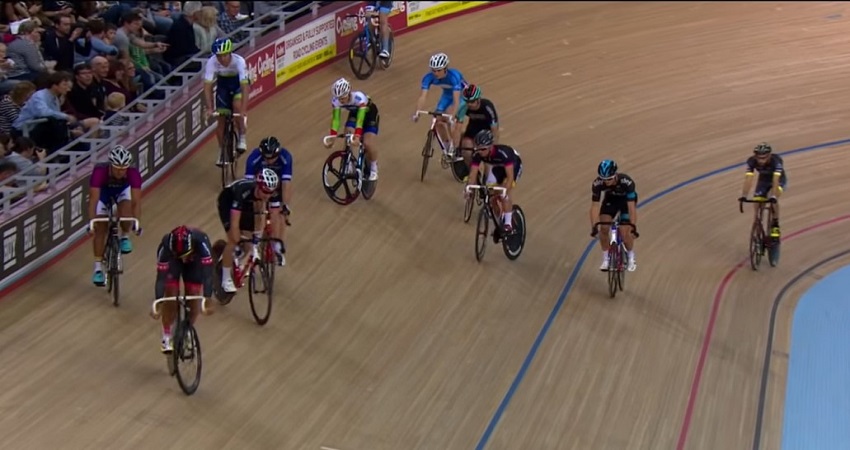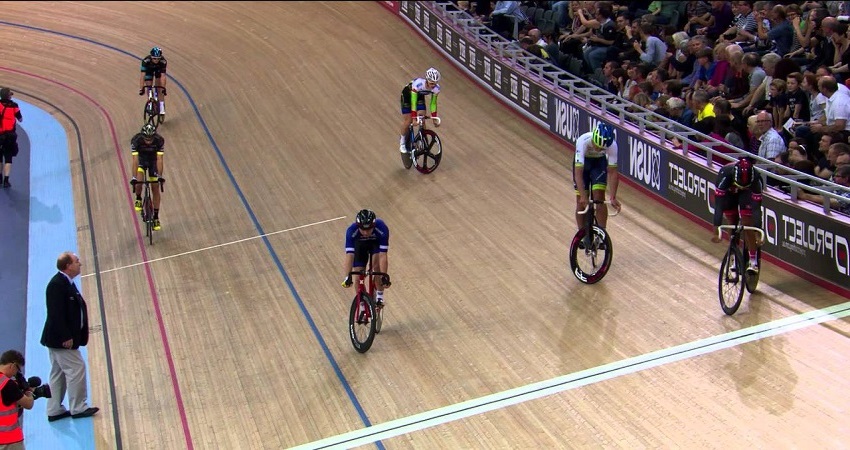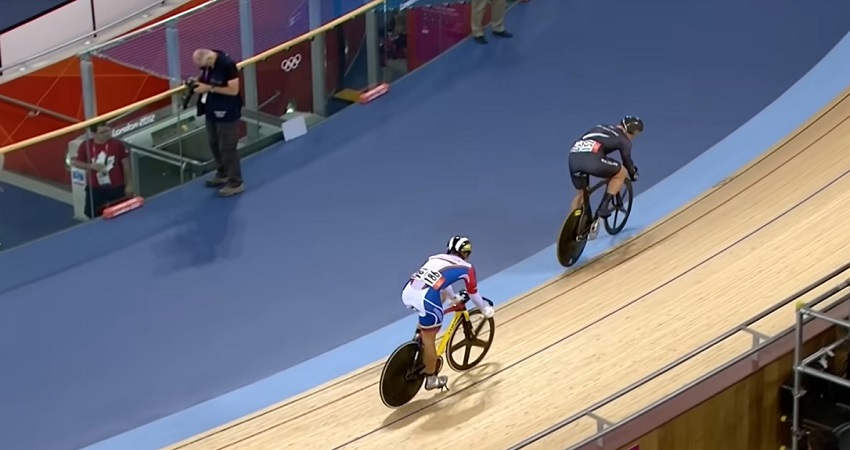
Velodrome bikes have solid wheels to maximize speed and enhance aerodynamic performance. These wheels eliminate air resistance and reduce rolling resistance, allowing riders to achieve higher speeds while preserving energy.
In addition to their streamlined design, solid wheels provide increased stability and responsiveness on the banked turns of a velodrome track, ensuring better control and maneuverability during races. Furthermore, the absence of spoke tension in solid wheels eliminates the risk of wheel deformation under high pressure, providing consistent and reliable performance throughout races.
Overall, the solid wheel design of velodrome bikes optimizes speed, maneuverability, and stability, making them the ideal choice for competitive track cycling.
The Purpose Of Solid Wheels
Velodrome bikes have solid wheels to enhance performance and safety on the track. These wheels provide increased stability, responsiveness, and eliminate the risk of punctures, allowing riders to focus solely on speed and precision.
Have you ever wondered why velodrome bikes have solid wheels instead of traditional spokes? It turns out there are several reasons behind this design choice. In this article, we’ll explore the purpose of solid wheels, including faster speeds, improved aerodynamics, and enhanced stability.
Faster Speeds
One of the main advantages of solid wheels on velodrome bikes is the ability to achieve faster speeds. The solid construction eliminates the need for spokes, reducing air resistance and friction. With fewer obstacles to overcome, the bike can slice through the air more efficiently, allowing riders to reach impressive velocities.
Improved Aerodynamics
Aerodynamics play a crucial role in cycling, especially on the velodrome where every second counts. The solid wheels offer superior aerodynamic performance compared to traditional spoked wheels. Their sleek and uninterrupted surface minimizes drag, enabling riders to maintain a streamlined position and gain an edge against competitors.
Enhanced Stability
Another significant benefit of solid wheels is the enhanced stability they provide. The absence of spokes eliminates any possibility of wheel flex or wobbling, ensuring a more stable and controlled ride. This stability allows riders to confidently navigate tight corners at high speeds, as the solid wheels provide a strong and reliable connection with the track.
In conclusion, the purpose of solid wheels on velodrome bikes goes beyond aesthetics. These wheels offer faster speeds, improved aerodynamics, and enhanced stability, providing riders with a competitive advantage. So the next time you watch a velodrome race, you’ll have a better understanding of the engineering behind those solid wheels.
Design And Construction Of Solid Wheels
Velodrome bikes feature solid wheels due to their superior design and construction. These wheels provide enhanced stability, speed, and maneuverability, making them ideal for the intense racing environment of the velodrome.
When it comes to velodrome bikes, one of the most notable features is their solid wheels. These wheels play a crucial role in optimizing the performance of the bike on the track. In this section, we will explore the design and construction of solid wheels, highlighting the use of lightweight materials, rigid construction, and their impact on traction and grip.
Lightweight Materials
Velodrome bikes are all about speed, and using lightweight materials for the construction of solid wheels is imperative to achieve maximum velocity. These wheels are typically made from carbon fiber composite materials, known for their exceptional strength-to-weight ratio. By utilizing lightweight materials, velodrome bikes can minimize rotational inertia, allowing riders to reach higher speeds and maintain momentum while pedaling.
Rigid Construction
In addition to being lightweight, solid wheels for velodrome bikes are designed with rigidity in mind. The rigidity of the wheels ensures optimal power transfer from the rider’s pedal strokes to the track surface. This rigid construction minimizes any energy loss that could occur due to flexing or deformation in the wheels, ultimately maximizing the efficiency of each pedal stroke. The combination of lightweight materials and rigid construction results in a dynamic and responsive ride that enhances the overall performance of the bike.
Traction And Grip
Another essential aspect of solid wheels for velodrome bikes is their ability to provide exceptional traction and grip on the track. The smooth, solid surface of these wheels ensures a large contact area with the track, maximizing the friction between the bike and the surface. This increased traction allows riders to corner with precision and maintain control at high speeds.
Furthermore, the lack of air-filled tires on velodrome bikes means there are no concerns about tire pressure or punctures. This removes potential variables that could affect performance during a race. Solid wheels provide a consistent and reliable contact point with the track, allowing riders to focus solely on generating speed and maneuvering around the velodrome.
In summary, the design and construction of solid wheels for velodrome bikes are essential in optimizing performance on the track. Utilizing lightweight materials, incorporating rigid construction, and providing excellent traction and grip contribute to the overall speed and maneuverability of these bikes. Now that we understand why velodrome bikes have solid wheels, we can appreciate the engineering behind these incredible machines and the impact they have on competitive cycling.
Advantages Of Solid Wheels
Better Power Transfer
One of the key advantages of solid wheels on velodrome bikes is the better power transfer they offer. The absence of spokes allows for a more direct transfer of power from the cyclist’s legs to the wheels, resulting in a more efficient and responsive ride. With no energy wasted in flexing spokes, riders can maximize their pedal strokes and generate more speed on the track.
Reduced Rolling Resistance
Solid wheels also contribute to reduced rolling resistance, which is crucial for velodrome racing. Unlike traditional spoked wheels that can experience some deformation under load, solid wheels maintain their shape and create a smoother surface for the tires to glide on. This means less friction between the tires and the track, allowing riders to maintain higher speeds with less effort.
Increased Durability
Another advantage of solid wheels is their increased durability. Since there are no delicate spokes to worry about, solid wheels are more resistant to damage from impacts or crashes. This durability is especially important in the fast-paced and competitive environment of velodrome racing, where riders often engage in aggressive maneuvers and close proximity riding. Solid wheels offer riders peace of mind knowing that their wheels can withstand intense racing conditions without compromising performance.
Considerations For Track Cycling
Velodrome bikes have solid wheels for track cycling due to their enhanced stability, reduced rolling resistance, and improved aerodynamics, allowing riders to achieve higher speeds on the smooth surface of the track. This design consideration ensures optimal performance and efficiency during track cycling events.
When it comes to track cycling, the equipment used plays a crucial role in the performance and safety of the athletes. One essential component that sets track bikes apart from their road counterparts is the solid wheels they feature. In this section, we will delve into the various considerations that led to the adoption of solid wheels in velodrome bikes.
Maintenance And Repair
Maintenance and repair represent significant factors to consider when it comes to track cycling. With the rigorous training and intense racing that takes place on the velodrome, the wheels of track bikes are subjected to relentless stress and strain. Using solid wheels eliminates the need for regular maintenance associated with traditional spoked wheels. There are no spokes to adjust, rims to true, or flats to repair as there are no tubes or tyres. This allows athletes to focus their time and energy on training and racing, rather than wasting it on constant wheel maintenance.
Limitations On Outdoor Use
Track cycling primarily takes place in indoor velodromes, and the solid wheels are specifically tailored for this purpose. These wheels are not designed to withstand outdoor conditions, such as rough roads, potholes, or varied terrain. The absence of air-filled tires makes the track bike highly unsuitable for outdoor use. The solid wheels are optimized for the smooth track surface of the velodrome, providing athletes with maximum speed and control.
Specialized Training
Track cycling requires a specialized skill set and a unique approach to training. The solid wheels on velodrome bikes contribute to this specialized training. The absence of any flex in the wheels provides immediate and direct power transfer from the athlete to the track. This enables riders to generate maximum acceleration and maintain speed, essential in track racing. Additionally, the solid wheels promote a more responsive and precise feel, allowing riders to maneuver tightly around the velodrome bends with increased confidence and control.
Future Developments And Alternatives
Velodrome bikes have solid wheels to enhance speed and maneuverability, helping cyclists reach new limits. Future developments may introduce alternative wheel designs, but for now, the solid wheels remain a staple in this high-speed sport.
As velodrome bikes continue to push the boundaries of speed and performance, it’s no wonder that there are ongoing developments in technology and design. In this section, we will explore some of the exciting future developments and alternatives to the traditional solid wheels used in velodrome bikes.
Tubeless Systems
One potential future development for velodrome bikes is the adoption of tubeless systems. Currently popular in mountain biking and road cycling, tubeless tires offer numerous advantages. By removing the tube and using an airtight seal between the tire and the rim, tubeless systems eliminate pinch flats and reduce rolling resistance. This results in a smoother and faster ride on the velodrome.
Tubeless systems also provide improved puncture resistance, as the sealant used in these tires can seal small cuts or punctures on its own. This means riders can focus more on their performance without worrying about potential disruptions caused by tire damage. Additionally, tubeless systems often allow for lower tire pressures, contributing to enhanced traction and control on the velodrome surface.
While tubeless systems may not be widely adopted in velodrome racing yet, their potential advantages make them a promising area for future development and innovation in the cycling industry.
Carbon Fiber Composites
Carbon fiber composites are revolutionizing the world of cycling and have the potential to transform velodrome bike wheels. Carbon fiber offers a unique combination of strength, stiffness, and lightness, making it an ideal material for constructing high-performance bike components.
In the context of velodrome bikes, carbon fiber composites allow for the creation of incredibly lightweight yet robust wheels. These wheels can significantly improve acceleration and maneuverability, giving riders a competitive edge on the track.
Furthermore, carbon fiber composites can be engineered to have specific stiffness characteristics. This enables fine-tuning of the wheel’s performance, ensuring optimal power transfer and responsiveness during sprints and turns. With ongoing advancements in carbon fiber manufacturing techniques, we can expect to see continued developments in velodrome bike wheels that take full advantage of this remarkable material.
Airless Tires
Airless tires represent another alternative that could potentially revolutionize velodrome bikes. Traditionally, bike tires rely on inflatable tubes that provide cushioning and flexibility. However, airless tires eliminate the need for tubes by utilizing innovative technologies and materials.
One such technology is the use of honeycomb structures. By incorporating a honeycomb-like pattern into the tire’s construction, it can provide cushioning and shock absorption similar to traditional air-filled tires, without the risk of punctures or flats. These airless tires would offer the advantage of enhanced durability and minimal maintenance, making them an attractive option for velodrome racers.
In addition to honeycomb structures, other airless tire designs utilize high-tech polymers and elastomers to provide the necessary flexibility and responsiveness. These materials can be engineered to offer a high level of grip, ensuring optimal traction on the velodrome surface.
| Benefits of Airless Tires |
|---|
| 1. Eliminates the risk of flats and punctures |
| 2. Enhanced durability for prolonged use |
| 3. Minimal maintenance and no need for tire pressure adjustments |
| 4. Consistent performance and grip on the velodrome |
While airless tires are still in the early stages of development and may not be suitable for all cycling disciplines, they certainly hold potential for optimizing velodrome bike performance. Further research and testing will help determine if airless tires become a feasible and advantageous option for velodrome racing.
Frequently Asked Questions On Why Do Velodrome Bikes Have Solid Wheels?
Why Do Velodrome Bikes Have Solid Wheels?
Velodrome bikes have solid wheels to maximize speed and control on the track. Solid wheels eliminate the need for spokes, reducing wind resistance and improving aerodynamics. This allows riders to maintain higher speeds and navigate corners more efficiently, enhancing their overall performance in velodrome racing.
Are Solid Wheels Better For Velodrome Racing?
Yes, solid wheels are highly advantageous for velodrome racing. Their lack of spokes reduces wind resistance, allowing riders to achieve higher speeds. Additionally, solid wheels provide increased stability and control, especially when navigating tight turns and corners on the velodrome track.
This makes them the preferred choice for professional velodrome racers.
Can Velodrome Bikes Use Regular Spoked Wheels?
Velodrome bikes can use regular spoked wheels, but solid wheels are the preferred choice for competitive racing. Regular spoked wheels have more wind resistance, which can affect speed. Additionally, solid wheels offer better aerodynamics, leading to improved performance on the velodrome track.
Professional riders often opt for solid wheels to maximize their speed and control.
How Do Solid Wheels Affect The Performance Of Velodrome Bikes?
Solid wheels have a significant impact on the performance of velodrome bikes. By reducing wind resistance and improving aerodynamics, solid wheels allow riders to attain higher speeds and maintain better control on the track. This helps in achieving faster lap times, increased efficiency in cornering, and ultimately, enhances the overall performance of velodrome bikes.
Conclusion
Velodrome bikes have solid wheels for several reasons. Firstly, solid wheels eliminate the need for spokes, reducing wind resistance and improving aerodynamics. Secondly, they provide better stability and control when cycling at high speeds on the velodrome track. Lastly, solid wheels offer increased strength and durability, making them suitable for the demanding conditions of track cycling.
So, next time you watch a velodrome race, remember the importance of those solid wheels spinning rapidly on the track. Stay tuned for more fascinating insights into the world of cycling!




